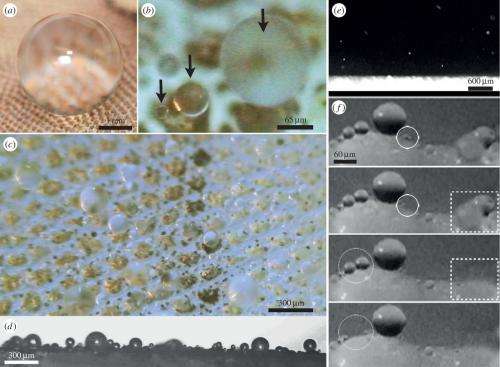March 13, 2015 report
Geckos found to have skin mechanism that flings off water (w/ video)

A small team of researchers with members from institutions in Australia and the U.K. has found that in addition to being able to walk on walls, at last one type of gecko has a skin feature that causes water to be thrown off its body. In their paper published in Journal of the Royal Society Interface, the team describes their close up study of the lizard's skin and the features and forces at work they discovered.
Everyone knows that geckos can walk on ceilings and walls, scientists have been studying them closely to see how they do it so their skill can be mimicked by us humans. Now it appears that they have another feature that might provide us benefits as well—skin that automatically ejects water off its surface.
In studying the wild box-patterned gecko, native to Australia, the researchers noted (using a scanning electron microscope) that its skin was covered with tiny spines, each just a few micrometers in length. Using other techniques they also found that the skin of the gecko actually ejected water droplets, causing the skin to dry quickly (which could be useful in preventing disease and warding off mold).
Analysis of the process showed that as water made its way to the skin, via rain, humidity, dew, etc. it was forced into drops by the spines, rather than forming a layer across the surface. As more water was collected, the drops grew bigger, and then, at a tipping point, they were ejected, pushed out as if a kernel of popping corn on the stove. The ejection mechanism, the team found was in the hydrophobic spines. The researchers also noted that the tipping point could also be reached very quickly by an external drop colliding with one already present on the skin—and very small drops could also be ejected as well.
It is not known if other types of geckos have the same abilities, as they have not been tested, though the researchers point out that others have been found to have similar skin spines, which makes the possibility of water ejection likely. In any case, it is likely that some future researches will move their focus from the special feet of the lizards to their skin in hopes of finding a way to use its water ejecting skill for use in human products, such as windows, etc.
More information: Removal mechanisms of dew via self-propulsion off the gecko skin, Journal of the Royal Society Interface, Published 11 March 2015. DOI: 10.1098/rsif.2014.1396
Abstract
Condensation resulting in the formation of water films or droplets is an unavoidable process on the cuticle or skin of many organisms. This process generally occurs under humid conditions when the temperature drops below the dew point. In this study, we have investigated dew conditions on the skin of the gecko Lucasium steindachneri. When condensation occurs, we show that small dew drops, as opposed to a thin film, form on the lizard's scales. As the droplets grow in size and merge, they can undergo self-propulsion off the skin and in the process can be carried away a sufficient distance to freely engage with external forces. We show that factors such as gravity, wind and fog provide mechanisms to remove these small droplets off the gecko skin surface. The formation of small droplets and subsequent removal from the skin may aid in reducing microbial contact (e.g. bacteria, fungi) and limit conducive growth conditions under humid environments. As well as providing an inhospitable microclimate for microorganisms, the formation and removal of small droplets may also potentially aid in other areas such as reduction and cleaning of some surface contaminants consisting of single or multiple aggregates of particles.
Journal information: Journal of the Royal Society Interface
© 2015 Phys.org



















